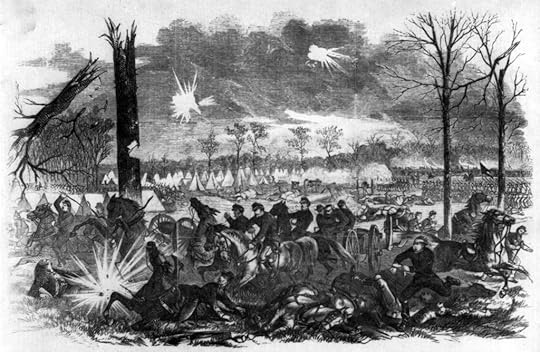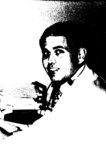Sunday, Bloody Sunday: Ghosts & Haunts of Shiloh
LONG SHADOWS: More Ghosts and Haunts of the Civil War

Sunday is a day of rest, or it should be–all the more so if it is Easter Sunday. April sixth, 1862 started out that way for the Union troops of General Grant’s army encamped along the Tennessee River at Pittsburg Landing in west Tennessee. This was where most of General Grant’s men had ended up, although initially they were supposed to gather at the river port of Savannah Tennessee.
In any case, all seemed placid. Most men were sleeping in; a few early risers had begun breakfast, others were just lolling about, enjoying their leisure. There had been some shots in the distance when it was still pitch black, but no one took notice—probably a nervous guard or two, is all. As men dreamed dreams of home and loved ones, blood-curdling yells broke the peace.
Men awoke, groggy and disoriented, to suddenly find a bayonet descending on them the next second.
As Ambrose Bierce observed, “many of Grant’s men when spitted on Confederate bayonets were as naked as civilians; but it should not be allowed that this was not because of any defect in their picket line. Their error was of another sort: they had no pickets.”
 Grant’s men advancing to the rear on the first day of Shiloh. Grant would later claim he was not taken by surprise and blamed almost every other Union general for the defeat but himself and Sherman.
Grant’s men advancing to the rear on the first day of Shiloh. Grant would later claim he was not taken by surprise and blamed almost every other Union general for the defeat but himself and Sherman.The outlying Union camps were quickly overrun. Federals hearing the commotion ran to grab their guns and rushed to the front only to find themselves too late, as successive waves of howling Rebels outflanked overran one after another Yankee positions. As the sun descended blood red in the west, the shattered remnants of Grants army huddled by the edge of the river, a leaderless mob, acting like condemned men awaiting their doom.
General “Bull” Nelson, at the head of the first relief column of Buell’s to unload at Pittsburg Landing at dusk on the sixth, threatened to open fire on the panic-stricken mob, and his division was only able to advance up the slope by fixing bayonets, ready to stick any of Grant’s men who got in their way.
In the weeks leading up to the battle, Grant had had ample time to build redoubts, entrenchments and other defenses to protect against surprise attack, yet failed to do so. Grant was not even at Pittsburg Landing, making his headquarters a number of miles away at Savannah, Tennessee.
Nor did Grant’s many regiments of cavalry and infantry do much patrol work outside their own bivouacs, as they may easily have done.
Still, one must give credit where credit is due: Grant knew how to write a great after-action report, and in it everyone but himself found some blame, save for his flame bearded—and some said crazy—friend General Sherman. Buell “went slow,” Wallace “went slow;” but apparently the Butternuts of Johnston & Beauregard’s army did not go slow on April sixth. Luckily, the Confederates failed to overrun the riverboat landing by sunset on the first day–they were too exhausted from their stunning victory. During the night, a fresh Federal army arrived and came across the river under General Don Carlos Buell to save the day—but that day would be April seventh, not the sixth.
If you read any one of the many books on Shiloh, the word that almost always comes to mind is “bloody.” While there would be many battles that would later prove as gory as Shiloh, this was the first fight where the bloodletting proved to be on such a staggering scale for both sides. Many a young man with a sweetheart at home never got to hold her in his arms; many a son was never to ever see his mother or sister.
The Bloody Pond exists as a reminder to the awful carnage and bloodletting of that day; it was said to have turned crimson from the blood of the men who went there to bath their wounds. Some wounded, crawling there with their last strength died in it face down in the water. Ever since that day, the pond will occasionally turn a livid hue of blood-red. Some say it is just reflecting the April blossoms on the trees, others dismiss it as a summer algae tainting it a crimson tint. Curse or coincidence, who is to say for sure?
Many who fell that day earned a mass grave alongside other unnamed souls in unhallowed ground and that alone would be enough to account for the many reported hauntings.
There is also a nearby Native American burial ground, which is also claimed to be a serious source of hauntings. The Shiloh Indian Mounds – are six rectangular mounds that served as platforms for the town’s important buildings. Five of the buildings are believed to have housed a council house, religious buildings, and homes. The sixth is believed to be the where the town’s leaders were interred. Visitors report cold gusts of wind, even during the heat of the day in summer. Colorful orbs are often observed darting in and out of the ground or hovering over mounds. If you listen carefully, one may even hear the faint sound of tribal chanting: witchy tai-to, ho ra nika, ho ra nika, hey hey, no-wah.
Is it any wonder that ever since that awful Sunday, those who have traversed the many acres that make up Shiloh battlefield have reported feeling strange feelings, hearing strange sounds and seeing strange sights?
There is, for example, the tale of the phantom drummer. I won’t recite the full story here, for it is told in full in Chapter 11 of Ghosts and Haunts of the Civil War. suffice it to say that on more than one occasion visitors to the national park have heard the sound of a distant drum, pounding out the “Long Roll,” when no re-enactor or musician is present anywhere on the grounds.
Lest we think these reports of ghosts and hauntings are just a product of modern tourism or social media sensationalism, written accounts of the battlefield and Pittsburg Landing being haunted date back to before it was even a national park.
One Union veteran, making a pilgrimage there in 1883, relates that, “one of the boats on this river has a mate, a large, powerful man, whom neither threats nor entreaties can induce to go ashore here at night. He tremblingly relates how, one dark night, he saw several soldiers in full uniform come aboard the boat and disappear over the bow. He also strongly claims to have seen whole regiments of spirit soldiers drill on the brink of the bluff, and to have heard the hollow, solemn voices of the officers giving commands.“
Other visitors to Shiloh claim to have heard the sounds of gunfire, or the moaning and screams of wounded men, desperately crying out for help. The Hornets’ Nest is one of several locations where such sounds have been heard. This location is renowned as a part of the battlefield which saw some of the most intense fighting on April sixth.
The Confederates repeatedly tried to take the Hornet’s Nest and “Sunken Road” position throughout the afternoon, but the Federals there kept them from breaking through to the landing. It was the scene of intense hand to hand combat as both sides fought with everything possible: as muskets, cannon, swords, knives, rifle-butts and bayonets. Visitors report hearing the sounds of cannons firing throughout the park, but much of it is coming from the direction of the Hornets’ Nest, which was finally taken only after a massed artillery barrage blew the defenders to pieces.
Since most visitors leave the park by sunset, only a select few have actually seen apparitions on the grounds. However, local residents, driving through the grounds at night, often encounter a strange encompassing fog and swear it’s filled with the shadowy figures of men slowly marching through it. Park rangers I have talked to angrily deny any such things ever occur.
Park officials, of course, are always concerned about trespassers, and uncanny accounts such as these could lure some folk to go where and when they aren’t allowed. Far be it from me to add to their concerns.
Still, many do believe the restless dead of Bloody Shiloh cannot be mollified. So, if you do go, you may only feel an eerie silence as I did; or possibly the sound of footsteps following you; you may even fancy you hear the distant sound of drumming. Is this just your imagination? Perhaps; or perhaps something more yet abides on the blood-drenched fields of Shiloh Battlefield.
For more about the restless shades of Shiloh and the Civil War, see Strange Tales of the Dark and Bloody Ground and Ghosts and Haunts of the Civil War.



